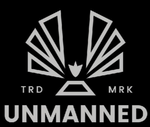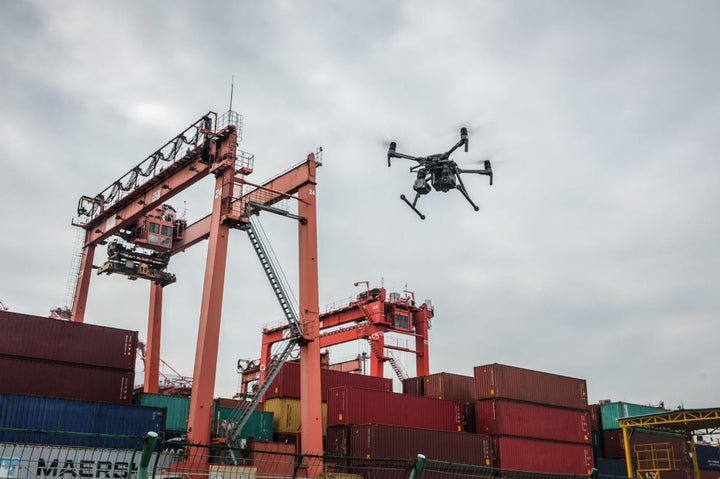Drone technology has gained widespread popularity over the past few years, especially with aerial photography enthusiasts, filmmakers, and hobbyists. Drones are being used for many different purposes. You may have even seen them being used in the military and agriculture industries.
If you’re curious and interested in learning about unmanned aerial vehicles (UAVs) or drones and buying them, you’ve come to the right place. In this article, we’ll break down all the basics you need to know to understand this unmanned aerial vehicle. This includes discussing what is a drone, how it works, its parts, the different types out there, and what qualities make a good drone.
What Is a Drone?
A drone, or an unmanned aerial vehicle (UAV), is a machine or small aircraft that can fly while being operated remotely or autonomously. It can carry out simple to dangerous tasks, like being used to film aerial shots or being used for military purposes. There are also different drones you can get in different sizes, configurations, features, and shapes.
Although drone technology isn’t relatively new, the expanded use and applications of drones is growing. It’s becoming more popular in various industries like agriculture, construction, and even in search and rescue operations. Here are its current possible uses:
- Surveillance
- Monitoring traffic
- Application of pesticides
- Archaeological inspection
- Weather measurements
- Military defense (distinguishment of objects from people)
- Cinematography
- Tracking and monitoring research studies
- Delivery of light goods
How Does a Drone Work
If you’re interested in buying your own drone, it’s essential to understand how it works. First of all, it works much like other aerial vehicles like airplanes and helicopters. You turn it on, it starts up, and its propellers rotate so it can fly. Then, you can either use a remote control or your phone to direct and control its flight and movements.
Parts of a Drone
One way to completely understand how a typical drone works is to know its main parts and how they contribute to making the UAV work. Here are the major components of a drone:
Propellers
These are responsible for all aspects of the drone’s movement: tilting, hovering, moving forward and backward, and turning. The propellers convert the motor power into thrust so the drone can propel through the air. They come in clockwise and counterclockwise pairs of rotating propellers and can be made of different materials such as plastic or carbon fiber.
Frame
This is the structural backbone of the drone that supports all the other components. It’s commonly made of sturdy but lightweight materials like plastic, carbon fiber, fiberglass, and even aluminum. It’s also usually made waterproof so it can protect the motor of the drone from water.
Drone frames come in many different shapes and designs, like X, H, and quadcopter configurations. Keep in mind that the design impacts the drone’s load capacity and maneuverability so it’s important to consider this when choosing or building a drone.
Motor
This generates the necessary power to the rotors and thrust to the drone so it can lift off the ground and maintain stability while in the air. Motors are usually brushless for improved efficiency and longevity since there’s less loss of energy due to friction. Its specifications like power, KV rating, and propeller compatibility also impact the drone’s overall performance and flight capabilities.
Controllers
There are two main controllers in a drone: the flight controller and the remote controller.
The flight controller is the brain of the drone and it manages various aspects of its flight. It’s equipped with different sensors like gyroscopes, barometers, accelerators, and others. This controller analyzes data from these sensors and constantly adjusts the motor’s speeds to maintain balance and respond to pilot commands.
The remote controller, on the other hand, is the transmitter. It allows the pilot to control the drone’s movement and its features. It’s the one the user uses to send commands to the drone and receive real-time telemetry data. It also usually has features like programmable buttons and integrated LCD screens.
Battery
The batteries supply the necessary power required to drive the motors and the drone as a whole. Drones usually used lithium-polymer (LiPo) batteries due to their high energy density and lightweight design. Its capacity affects the drone’s flight duration while the voltage determines the motor performance.
GPS and Navigation Systems
GPS (Global Positioning System) and navigation systems are responsible for the precise positioning, flight automation, and navigation of the drone. The GPS receivers in the drone gather satellite information to determine the drone’s location, altitude, and speed. This helps ensure a safe and convenient flight.
Different Types of Drones

What is a drone? Well, there are many types of drones you can find nowadays. The type can depend on various things like:
- Purpose: Consumer, Professional, and Industrial uses
- Wing Type: Multi-rotor, Single-rotor, Fixed-wing, Fixed-wing hybrid
- Size: Very small, Small, Medium, Large
- Payload capacity: Featherweight, Lightweight, Middleweight, Heavy-lift
- Drone range: Close, Short, Mid, Long
But, the most common types of drones on the market are the following:
1. Ready-to-Fly (RTF) Drones
These are drones that are already assembled in a complete package together with its needed controllers. If you’re a beginner in using drones, this is a recommended type for you since you won’t need anything else to start or use it.
2. Multi-Rotor Drones
These are also called quadcopters and are the most popular type of drone. Multi-rotor drones are typically the smallest and lightest drones, limiting their distance, speed, and height capabilities. However, these also make these drones the perfect choice for hobbyists and photographers. You can usually use it for 20-30 minutes in the air while carrying a lightweight payload, like a camera.
3. Fixed-Wing Hybrid VTOL Drones
This type is one of the latest drone technologies and is modified to take off and land vertically. These drones combine the long-range and flight time of fixed-wing drones with the vertical takeoff capability of rotary-wing devices, improving their overall maneuverability. This makes them the most versatile drones and the perfect choices for mapping and surveying.
Qualities of a Good Drone
If you’ll start looking at drone products, it’s important to make sure you’re going to get your money’s worth. As a beginner, look for these qualities for your first drone:
1. Good RangeDepending on how you’ll use the drone, for photography or others, there are different ranges your drone can come with. Think about how far and long you want it in the air. Make sure it has enough range to your liking or needs. If you’ll be using the drone for a hobby and taking pictures when you travel, getting a small drone with short-range capacity is enough.
2. Compact Size and DesignConsider a drone that’s compact enough to be easily packed in a backpack. This includes deciding on the rotating blade styles. Choose a functional and convenient size and design for a stable flight and portability.
3. Battery EfficientLastly, check the battery life of your preferred drone. Since you’ll most likely use the drone outdoors, where there’s not much source of electricity, you have to make sure that the battery life will last as long as you need it to.
How to Use a Drone
Lastly, here’s a simple step-by-step guide on how to fly and use a drone as a beginner:
1. Go to an Open AreaFind an open area where you can practice using your drone. It can be any outdoor open area as long as there are no obstructions and is safe. Make sure there’d be no walls, trees, and other obstructions that your drone may crash into.
2. Position Your DroneFind a good takeoff spot for your drone. When positioning it, make sure it’s positioned properly based on its instruction manual. Ideally, it should be in front of you and on a flat surface. You and the drone should also be facing the same direction.
3. Connect the TransmitterBefore switching on the transmitter, push the throttle way down. Then, turn the transmitter on and connect the drone’s battery. Make sure to follow this sequence before taking off and in reverse after landing the drone.
4. Takeoff and HoverNext is to practice takeoff and hovering. Slowly push the throttle (left stick) upwards to make the drone lift off. Lift it off at least a few feet above the ground and hold it in place as steadily as you can. Don’t move forward or to the sides yet.
5. Rotation and DirectionOnce you’ve learned how to takeoff and hover, you can now rotate and move your drone. Use the left stick’s yaw control on the controller. Launch your drone and slowly push the left stick right or left until the drone rotates to face you. For forward and backward movements, use the pitch and roll control stick or the right stick in the controller.
To successfully fly a drone, combine and practice all these steps together and you’ll be flying your drone in different ways in no time.
What Is a Drone – Conclusion
The drone technology is the latest UAV technology and it’s no surprise that many people like you are getting more interested in it. There are many more things to learn about drones aside from knowing what is a drone, especially how to use them. But, knowing the basics is a good starting point for beginners.
Once you’ve fully understood what we’ve discussed above, you can look through some of our good drone collections. We offer different types of drones with different features which can help you narrow down what you want for your own drone!


